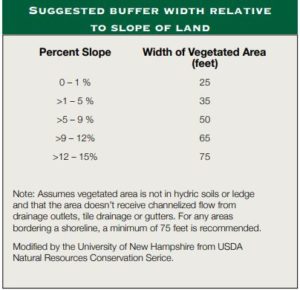
More and more of us are choosing to live near lakes, streams and rivers, with the expectation that our shoreline property will provide lovely views, wildlife habitat, and clean water for fishing, swimming, boating, and other recreational activities. But as development increases it can seriously affect the water quality of our lakes, rivers and streams. Visual signs of declining water quality include increased weed growth and erosion along shorelines, reduced water clarity, algal blooms, sediment deposits and altered wildlife habitat and diversity.
Vegetative buffers are areas of vegetation located between the water and additions to the original waterfront property, such as buildings, driveways, patios, and lawns. Plant buffers are an important tool to help lessen the adverse affects of human activity on water quality.
Composed of trees, shrubs, groundcovers and aquatic plants, buffers slow runoff and help catch nutrients, sediments and other pollutants before they can reach the water. The deep roots of trees and shrubs and the layer of leaf litter they provide act like a sponge to temporarily hold water and remove many of the contaminants.
Shoreline buffers perform a number of functions that have significant economic, ecological and social value, including:
• They provide a link between the water and the land and serve as transition zones between water and upland areas.
• Dense plantings of trees and shrubs can dampen the noise from boat engines, traffic and adjacent properties. In addition, they provide privacy.
• Vegetative buffers intercept raindrops and meltwater, reducing their impact on the soil. They also help slow the velocity of water running off the land, giving sediments, pollutants, and nutrients time to settle out on land before reaching the water. Suspended sediments in the water reduce the amount of sunlight that reaches submerged plants. This reduces the rate of photosynthesis and upsets the established ecology. Excessive sediments can smother life on the bottom, such as fish eggs and insects that are crucial parts of the food web. An overabundance of sediments can make the bottom mucky and the rocks slippery. Heavy deposits of sediment can create a growing area for unwanted species of rooted plants that change the composition of existing plant communities.
 • Vegetative buffers stabilize slopes and help protect banks from erosion. Roots hold the bank soils together and increase water infiltration. Roots and stems together protect
• Vegetative buffers stabilize slopes and help protect banks from erosion. Roots hold the bank soils together and increase water infiltration. Roots and stems together protect
the shore by deflecting the cutting action of currents, waves, boat wakes, wind and stormwater. In addition to holding soil in place, root systems absorb water and nutrients. Plant roots within vegetative buffers take up dissolved nutrients from fertilizers, animal waste, sewage, wastewater, and erosion and store them in their leaves, stems and roots, preventing those nutrients from reaching the water.
• Vegetative buffers help manage stormwater and reduce flooding. If intercepted by a vegetative buffer, pollutants such as petroleum products, road salt, heavy metals, fertilizers
and pesticides carried in stormwater may never reach open water.
• Buffers slow runoff flows, allowing water to infiltrate the soil and recharge the groundwater. Water slowed by a buffer enters the stream, river, pond or lake gradually
and over a longer period of time than water running off an impervious or poorly vegetated surface.
• Vegetative buffer areas provide essential habitat for many species of wildlife. Nearly one-third of New Hampshire’s native wildlife depends on aquatic and wetland habitats. Birds, mammals, fish, frogs, and turtles spend some or all of their life cycle in or around the water. Fallen tree branches and logs provide habitat for fish, turtles and other aquatic
wildlife. Aquatic plants and fallen debris also provide a refuge and a food source for insects, snails and other small creatures critical in the aquatic food chain. Plants along the water’s edge help moderate water temperatures by shading shallow water. This provides relief for aquatic organisms during the hot summer months.
• Buffer areas along the shoreline contain important nesting, hunting, feeding and perching areas for songbirds. Standing dead trees (or snags) provide nesting cavities for
woodpeckers, black-capped chickadees, nuthatches, ducks and other wildlife. Trees, shrubs, vines, and other plants produce a variety of nuts, berries and seed buds for squirrels, deer, grouse, turkey, wood ducks and bears. Plants along the shoreline attract insects that serve as food for many other species. • Buffers can serve as links between shoreline properties, providing a migration corridor for a wide variety of animals. On the other hand, one benefit of vegetative buffers is that Canada geese don’t like to move through brushy areas where they feel more vulnerable to predators. They will rarely cross a buffer to reach your lawn, where their droppings are unsanitary and objectionable.
• Buffers can serve as links between shoreline properties, providing a migration corridor for a wide variety of animals. On the other hand, one benefit of vegetative buffers is that Canada geese don’t like to move through brushy areas where they feel more vulnerable to predators. They will rarely cross a buffer to reach your lawn, where their droppings are unsanitary and objectionable.
• Vegetative buffers add aesthetic value. Branches of trees and shrubs can be used to frame a view. Selective removal of a few low branches can provide openings for views from your house to the water without significantly decreasing privacy. Vegetative buffers can help protect water quality, protect and provide habitat for wildlife, reduce noise, help stabilize the shoreline, reduce flood waters, moderate water temperatures and filter pollutants, nutrients and sediment. Buffers can do some or all of these things while maintaining aesthetic and recreational values.
Posted by Scott Freerksen “The Lake Guy”
